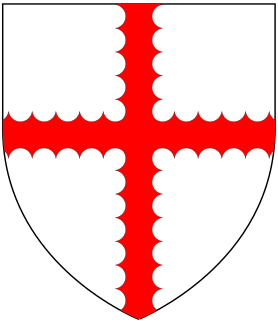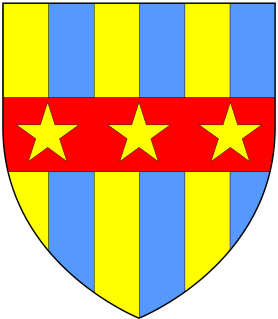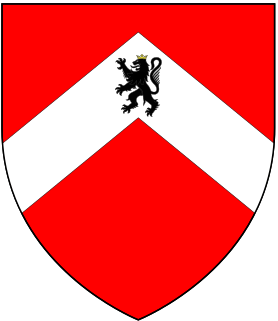Related Research Articles

Walter Hungerford, 1st Baron Hungerford was an English knight and landowner, from 1400 to 1414 a Member of the House of Commons, of which he became Speaker, then was an Admiral and peer.

John Stourton, 1st Baron Stourton of Stourton, Wiltshire, was an English soldier and politician, elevated to the peerage in 1448.
Events from the 1390s in England.

Sir Edward Dalyngrigge , possibly (Bo)ëdoñ·osard Daylyn/ Deïlïn - Drigge/ Draggi, known contemporaneously and historically as Sir Edward Dallingridge, was a 14th-century knight who built Bodiam Castle in Sussex, England.

Ralph Lumley, 1st Baron Lumley was an English nobleman, soldier and administrator under King Richard II, who was stripped of his lands, goods and title for rebelling against King Henry IV and executed.
Sir John Cheyne or Cheney was a Member of Parliament and briefly the initial Speaker of the House of Commons of England in the Parliament of October 1399, summoned by the newly acclaimed Henry IV.

Sir William Esturmy, of Wolfhall, Wiltshire was an English Knight of the Shire, Speaker of the House of Commons, and hereditary Warden of the royal forest of Savernake, Wiltshire.
Sir John Bussy of Hougham in Lincolnshire was a Member of Parliament representing Lincolnshire or Rutland eleven times from 1383 to 1398 as a Knight of the Shire. He was also Speaker of the House of Commons at the three Parliaments between 1393 and 1398, during which he supported the policies of king Richard II. He was most famous for orchestrating the abdication of parliament's power to an eighteen-man subcommittee in order to concentrate power in the hands of the king's supporters.
Sir Richard Redman was an English soldier, administrator and politician, being elected as a Member of Parliament representing Yorkshire and later acting as the Speaker of the House of Commons for the Parliament of 1415.
Sir Walter Beauchamp was an English lawyer and Speaker of the House of Commons of England between March and May 1416.
John Montagu, 3rd Earl of Salisbury and 5th and 2nd Baron Montagu, KG was an English nobleman, one of the few who remained loyal to Richard II after Henry IV became king.

Sir Maurice Russell of Kingston Russell, Dorset and Dyrham, Glos. was an English nobleman and knight. He was a prominent member of the Gloucestershire gentry. He was the third but eldest surviving son and heir of Sir Ralph Russell (1319–1375) and his wife Alice. He was knighted between June and December 1385 and served twice as Knight of the Shire for Gloucestershire in 1402 and 1404. He held the post of Sheriff of Gloucestershire four times, and was Coroner and Justice of the Peace, Tax Collector and Commissioner of Enquiry. His land holdings were extensive in Gloucestershire, Somerset, Dorset, Berkshire and Buckinghamshire. He was descended from an ancient line which can be traced back to 1210, which ended on the death of his son Thomas, from his second marriage, as a young man without male issue. Most of his estates, despite having been entailed, passed at his death into the families of his two daughters from his first marriage.
John Cobham was an English politician.
William Haute (1390–1462) of Bishopsbourne, Kent, was an English politician.

Thomas Clanvowe was a British landowner, Member of Parliament and Sheriff of Herefordshire.
Sir John Rochford or John de Rochford of Fenn of Boston, Lincolnshire, was an English politician. He was a Member (MP) of the Parliament of England for Lincolnshire November 1390, 1394, September 1397 and 1399 and for Cambridgeshire in 1407. He was knighted by 1399. He was appointed High Sheriff of Lincolnshire for 1391–92, 1400–01 and 1409–10, and Constable of Wisbech Castle, Cambridgeshire from 1401 to his death. He was married and having a son and two daughters.
Sir John Roches (c.1333–1400), of Bromham, Wiltshire, was an English admiral, diplomat, magistrate and politician.
Sir John Berkeley, of Beverston Castle, Gloucestershire was an English politician. He was knighted before 1383.
John Waterton was an English landowner, administrator, courtier, diplomat, and politician who sat in the Parliament of England.

Sir Thomas Brooke (c.1355-1418) of Holditch in the parish of Thorncombe in Devon and of la Brooke in the parish of Ilchester in Somerset, was "by far the largest landowner in Somerset" and served 13 times as a Member of Parliament for Somerset. He was the first prominent member of his family, largely due to the great wealth he acquired from his marriage to a wealthy widow. The monumental brass of Sir Thomas Brooke and his wife survives in Thorncombe Church.
References
- ↑ Woodger, L. S. "RIVER, Sir Henry de la (d.c.1400), of Tormarton, Glos". History of Parliament Online. Retrieved 3 July 2021.
- ↑ Members of Parliament: Parliaments of England, 1213-1702 By Great Britain. Parliament pg 247 on line
- ↑ "The parliamentary history of the county of Gloucester, including the cities of Bristol and Gloucester, and the boroughs of Cheltenham, Cirencester, Stroud and Tewkesbury, from the earliest times to the present day, 1213-1898" By W. R. WILLIAMS, Hereford, 1898 pg 39 on line
- ↑ John Silvester Davies, ed., The Tropenell Cartulary: being the contents of an old Wiltshire muniment chest, 2 vols. (Wiltshire Archaeological and Natural History Society, 1908) as text or as images